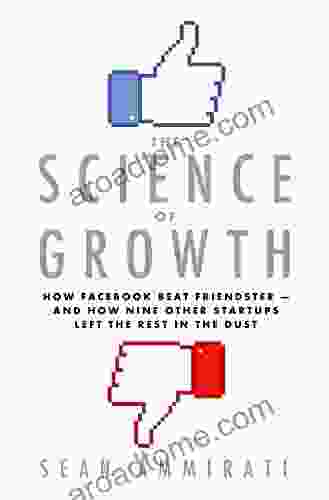How Facebook Beat Friendster: And How Nine Other Startups Left the Rest in the Dust

In the early days of the internet, social media was a wide-open field. There were dozens of startups vying for attention, and it seemed like anyone could become the next big thing.
4.4 out of 5
| Language | : | English |
| File size | : | 6542 KB |
| Text-to-Speech | : | Enabled |
| Screen Reader | : | Supported |
| Enhanced typesetting | : | Enabled |
| Word Wise | : | Enabled |
| Print length | : | 252 pages |
But in the end, it was Facebook that emerged as the clear winner. Friendster, once the most popular social media platform, was left in the dust. And nine other promising startups also failed to keep pace with Facebook's meteoric rise.
So what made Facebook so successful? And what mistakes did the other startups make?
In this article, we'll take a closer look at the story of how Facebook beat Friendster and the other startups. We'll examine the key factors that contributed to Facebook's success, and we'll also discuss the lessons that can be learned from the failures of the other startups.
The Rise of Facebook
Facebook was founded in 2004 by Mark Zuckerberg, a Harvard student. The site was originally designed as a way for Harvard students to connect with each other. However, it quickly became popular with students at other universities, and it soon spread to the general public.
There were several key factors that contributed to Facebook's success.
- First, Facebook was very easy to use. The site had a simple interface that made it easy for users to create profiles, add friends, and share content.
- Second, Facebook was very social. The site allowed users to connect with friends and family, as well as meet new people. This made it a great place to socialize and build relationships.
- Third, Facebook was constantly innovating. The site was constantly adding new features, such as the News Feed, the Timeline, and the Messenger app. This kept users engaged and coming back for more.
The Fall of Friendster
Friendster was founded in 2002, two years before Facebook. The site was initially very popular, and it quickly became the largest social media platform in the world. However, Friendster's popularity began to decline in 2004, when Facebook was launched.
There were several factors that contributed to Friendster's decline.
- First, Friendster was not as easy to use as Facebook. The site had a more complex interface, and it was more difficult for users to create profiles and add friends.
- Second, Friendster was not as social as Facebook. The site did not allow users to connect with friends and family, and it was more difficult to meet new people.
- Third, Friendster did not innovate as quickly as Facebook. The site did not add new features as often as Facebook, and this caused users to lose interest.
The Lessons Learned
The story of how Facebook beat Friendster and the other startups is a valuable lesson for any entrepreneur. It shows that success is not always about having the best product. It is also about having the right strategy, the right team, and the right execution.
Here are some of the lessons that can be learned from the story of Facebook's success:
- Make your product easy to use. The easier your product is to use, the more likely people are to use it.
- Make your product social. People want to connect with others, so make sure your product allows them to do so.
- Constantly innovate. The world is constantly changing, so you need to make sure your product is constantly evolving.
- Build a strong team. The success of any startup depends on the team behind it. Make sure you have a team of talented and dedicated people.
- Execute your plan. Once you have a plan, you need to execute it effectively. This means setting realistic goals, tracking your progress, and making adjustments as necessary.
The story of how Facebook beat Friendster and the other startups is a reminder that anything is possible. If you have a great product, a strong team, and a solid plan, you can achieve success.
So don't be afraid to dream big. And don't give up on your dreams. With hard work and dedication, you can achieve anything you set your mind to.
4.4 out of 5
| Language | : | English |
| File size | : | 6542 KB |
| Text-to-Speech | : | Enabled |
| Screen Reader | : | Supported |
| Enhanced typesetting | : | Enabled |
| Word Wise | : | Enabled |
| Print length | : | 252 pages |
Do you want to contribute by writing guest posts on this blog?
Please contact us and send us a resume of previous articles that you have written.
 Book
Book Novel
Novel Page
Page Chapter
Chapter Text
Text Story
Story Genre
Genre Reader
Reader Library
Library Paperback
Paperback E-book
E-book Magazine
Magazine Newspaper
Newspaper Paragraph
Paragraph Sentence
Sentence Bookmark
Bookmark Shelf
Shelf Glossary
Glossary Bibliography
Bibliography Foreword
Foreword Preface
Preface Synopsis
Synopsis Annotation
Annotation Footnote
Footnote Manuscript
Manuscript Scroll
Scroll Codex
Codex Tome
Tome Bestseller
Bestseller Classics
Classics Library card
Library card Narrative
Narrative Biography
Biography Autobiography
Autobiography Memoir
Memoir Reference
Reference Encyclopedia
Encyclopedia Ali Drucker
Ali Drucker Steve Andreas
Steve Andreas Sandeep Unnithan
Sandeep Unnithan Theodore Millon
Theodore Millon Sheila Pollard
Sheila Pollard Will Benson
Will Benson Sandra Gordillo
Sandra Gordillo Alan Long
Alan Long Yael Shoval
Yael Shoval William Bodri
William Bodri Roy Kistner
Roy Kistner Marilyn K Hagar
Marilyn K Hagar Silk Cotton
Silk Cotton Michele O Mara
Michele O Mara Simon P Keefe
Simon P Keefe Ryan J S Martin
Ryan J S Martin Lisa James
Lisa James Nancy Friday
Nancy Friday Wayne Pease
Wayne Pease Stephen Baker
Stephen Baker
Light bulbAdvertise smarter! Our strategic ad space ensures maximum exposure. Reserve your spot today!

 Norman ButlerEngineering Practices For Management Of Soil Salinity: The Key To Sustainable...
Norman ButlerEngineering Practices For Management Of Soil Salinity: The Key To Sustainable...
 Francisco CoxThe Dietary Guide to Managing Interstitial Cystitis for Beginners: Relieve...
Francisco CoxThe Dietary Guide to Managing Interstitial Cystitis for Beginners: Relieve... Billy FosterFollow ·17.6k
Billy FosterFollow ·17.6k Ken SimmonsFollow ·4.4k
Ken SimmonsFollow ·4.4k Vincent MitchellFollow ·3.4k
Vincent MitchellFollow ·3.4k Heath PowellFollow ·14.5k
Heath PowellFollow ·14.5k Nathan ReedFollow ·6.7k
Nathan ReedFollow ·6.7k Tony CarterFollow ·12.1k
Tony CarterFollow ·12.1k Josh CarterFollow ·14.6k
Josh CarterFollow ·14.6k Tom HayesFollow ·14.3k
Tom HayesFollow ·14.3k

 Timothy Ward
Timothy WardSteamy Reverse Harem with MFM Threesome: Our Fae Queen
By [Author...

 Cody Blair
Cody BlairThe Ultimate Guide to Energetic Materials: Detonation and...
Energetic materials are a fascinating and...

 Kenzaburō Ōe
Kenzaburō ŌeProstitution, Modernity, and the Making of the Cuban...
By Emily A....

 Kirk Hayes
Kirk HayesUnveil the Enchanting World of The Rape of the Lock by...
Alexander Pope's epic...

 Ivan Turgenev
Ivan TurgenevTantric Quest: An Encounter With Absolute Love
Embark on a Tantric Quest to...

 Gary Reed
Gary ReedThe Darwin Awards: Evolution in Action
The Darwin Awards are a...
4.4 out of 5
| Language | : | English |
| File size | : | 6542 KB |
| Text-to-Speech | : | Enabled |
| Screen Reader | : | Supported |
| Enhanced typesetting | : | Enabled |
| Word Wise | : | Enabled |
| Print length | : | 252 pages |








